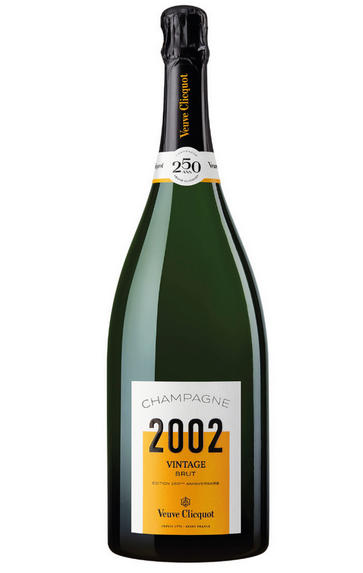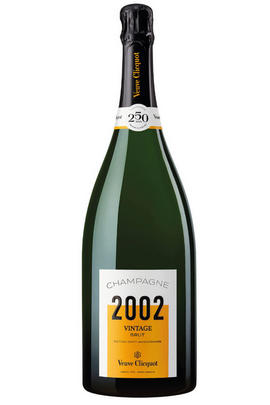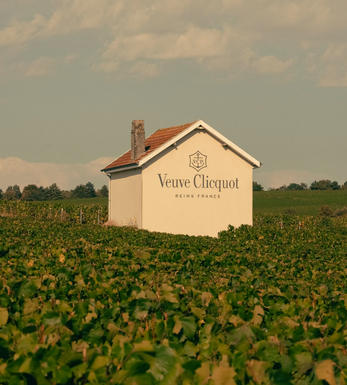
2002 Champagne Veuve Clicquot, 250th Anniversary Edition, Brut

About this WINE

Veuve Clicquot
Philippe Clicquot-Muiron established Veuve Clicquot in 1772. However, it was Phillipe`s daughter-in-law, Nicole-Barbe Clicquot, who really laid the foundations of the modern company. She was one of the great innovators - it was she who invented remuage in the early 19th century. Now it is part of the LVMH group. The Non-Vintage Brut is a blend of 55% Pinot Noir, 30% Chardonnay and 15% Pinot Meunier. It has a nose of white fruits and freshly baked bread and is fresh and balanced on the palate. The vintage wines are similar in character but with more depth of fruit and more structure. La Grande Dame, first made in 1969, is a rich, smooth and finely textured Champagne that simply oozes class and breeding.

Brut Champagne
Brut denotes a dry style of Champagne (less than 15 grams per litre). Most Champagne is non-vintage, produced from a blend from different years. The non-vintage blend is always based predominately on wines made from the current harvest, enriched with aged wines (their proportion and age varies by brand) from earlier harvests, which impart an additional level of complexity to the end wine. Champagnes from a single vintage are labelled with the year reference and with the description Millésimé.
Non-vintage Champagnes can improve with short-term ageing (typically two to three years), while vintages can develop over much longer periods (five to 30 years). The most exquisite and often top-priced expression of a house’s style is referred to as Prestige Cuvée. Famous examples include Louis Roederer's Cristal, Moët & Chandon's Dom Pérignon, and Pol Roger's Cuvée Sir Winston Churchill.
Recommended Producers : Krug, Billecart Salmon, Pol Roger, Bollinger, Salon, Gosset, Pierre Péters, Ruinart

Champagne blend
Which grapes are included in the blend, and their proportion, is one of the key factors determining the style of most Champagnes. Three grapes are used - Pinot Noir, Chardonnay and Pinot Meunier.
26% of vineyards in Champagne are planted with Chardonnay and it performs best on the Côtes des Blancs and on the chalk slopes south of Epernay. It is relatively simple to grow, although it buds early and thus is susceptible to spring frosts. It produces lighter, fresher wines than those from Burgundy and gives finesse, fruit and elegance to the final blend. It is the sole grape in Blancs de Blancs, which are some of the richest long-lived Champagnes produced.
Pinot Noir accounts for nearly 40% of the plantings in Champagne and lies at the heart of most blends - it gives Champagne its body, structure, strength and grip. It is planted across Champagne and particularly so in the southern Aube district.
The final component is Pinot Meunier and this constitutes nearly 35% of the plantings. Its durability and resistance to spring frosts make the Marne Valley, a notorious frost pocket, its natural home. It ripens well in poor years and produces a soft, fruity style of wine that is ideal for blending with the more assertive flavours of Pinot Noir. Producers allege that Pinot Meunier lacks ageing potential, but this does not deter Krug from including around 15% of it in their final blends.


Buying options
Add to wishlist
Description
This special limited edition bottling of the 2002 Veuve Clicquot Vintage Reserve en magnum is in celebration of Veuve Clicquot’s 250th Anniversary. Disgorged in 2022, this exceptional release pays homage to Madame Clicquot and her visionary spirit.
This late disgorgement is only available in magnum, the optimum vessel for prolonged ageing on lees and essential to the signature style of this complex, rounded and rich champagne. Not only is it drinking in its prime now, but it also has the potential to age for another two decades.
On the nose, you are immediately greeted with a bouquet of baked orchard fruits and peach cobbler. A youthful freshness comes from freshly squeezed citrus and floral hints too. There is a marked freshness on the palate, but this moves into richer complex characteristics, and dried red fruit notes come through from the dominant pinot noir, which makes up 60% of the blend.
The finish is nutty with hints of seashells, minerality, baked croissants and sweet honey. The generous fruit profile here continues right through to the finish, and there is potential here to enjoy anytime in the next 15 years.
Amy Johnson, Account Manager, Berry Bros. & Rudd (July 2023)
The nose of this is thoroughbred Veuve, showing a lovely concentration of white stone fruits and gentle floral aromas. Despite its late disgorgement, the palate is still incredibly bright and fresh, suggesting much potential for cellaring.
Notes of pear, ripe apple, and even hints of some hedgerow fruits are complimented by baking spices, sweet honeycomb and just a hint of patisserie. The finish is bright and lively, lingering on the palate for some time. This will drink very nicely during the next ten summers, and being in magnum, it couldn’t be better suited to a garden party! Drink now and over the next 10-12 years for optimum balance.
Paul Keating, Senior Account Manager, Berry Bros. & Rudd (July 2023)
wine at a glance
Delivery and quality guarantee